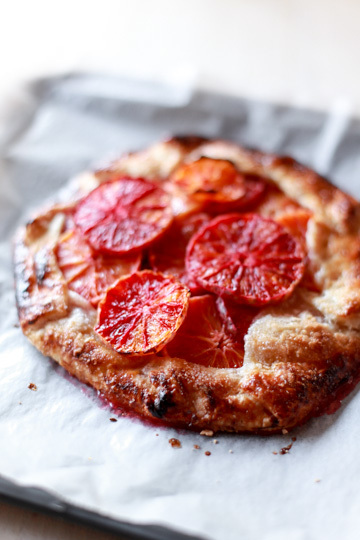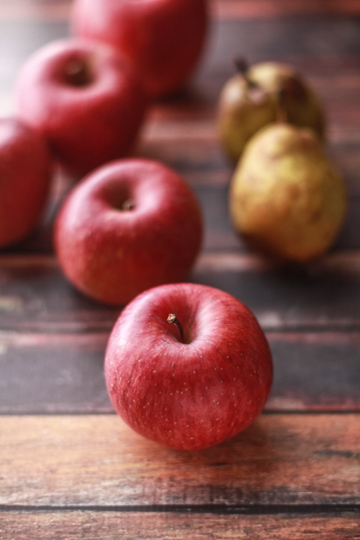... and just like that, I'm here! Is anybody out there?
It feels funny to be back here writing a real, proper blog post on my laptop instead of doing an Instagram post on my iPhone as it has become my habit these past years. This is my first blog post in more than four years(!). And yet, I have never positively decided to quit blogging - not really.
The thought of blogging has crossed my mind more than a few times over the years. It would come to me when I was writing a particularly lengthy IG post. I would wonder: Isn't this precisely what you have a blog for? And so, here I am, popping back to share a little story about a cookie with the world - I even have a recipe, too! I can't say I'll be back on regular posting schedule here (after all, Instagram is basically my blog now), but we'll see.
OK, so, about the cookie.
It all started when I was in the town of Kotor, Montenegro, this past June, on a day trip I took from Dubrovnik, Croatia. I'll be doing some posts about the trip on Instagram, but sticking to my purpose today (i.e. the cookie): I had about three hours of free time to explore the coastal town, and I had my mind set on walking up to Castle of San Giovanni. (In fact, it was the highlight of my trip to Montenegro.)
As I didn't expect to have enough time to go to a restaurant and eat proper lunch, I'd picked up a box of healthy-ish looking cookies at a corner shop earlier the day, when we'd stopped by a pretty town of Perast. The plan was to just snack on them on my walk up to the castle.
Castle of San Giovanni, also called St. John’s Fortress, sits atop a hill 280 meters (920 feet) high, with spectacular views of Kotor's Old Town and the Bay of Kotor. To get there, you climb up some 1,350 steps; let's just say it's a bit of a hike.
 |
| A view of the Bay of Kotor from the path going up to Castle of San Giovanni, Kotor, Montenegro. |
And so, the cookies (yes, we are finally there). At the small store in Perast, I didn't have a lot of time to browse but the packaging of the cookies sort of jumped at me - an image of lemon and mint. It was called "Limunana", which I take it to mean "mint lemonade", from a brand called Bambi Wellness, and I remember thinking it was an interesting flavor for a mass-produced cookie. It sounded great on a hot, summer-like day like we had then.
Soon after I started climbing up the stairs to the fortress, I opened the box. My mind wasn't particularly on the cookies and I just took a bite without much thought of them - then I nearly stopped in my tracks. This is rather nice, I thought - it was lemony, minty, crunchy, wholesome, and not too sweet. I took another bite, then another. It was really nice. I was hooked.
 |
| Bambi Wellness "Limunana" cookies |
After Dubrovnik, I came (almost) straight back to Japan, and the half-empty box of the lemon-mint cookies came home with me. I hadn't seen the brand before, and I was quite sure it wouldn't be available back in Japan (and it wasn't - I asked). Besides, the cookie was a limited-time flavor, i.e. only available this summer. So the chance of my being able to get my hand on it ever again was pretty slim.
The only sensible thing to do, it seemed to me, would be to try and recreate it on my own.
 |
| Limunana cookie, up close and personal |
Texture-wise, it was decidedly crunchy - definitely not chewy, and I liked it that way. It reminded me of digestive biscuits from Britain (my all-time favorite being McVitie's Digestives) and perhaps English oat cookies (like Hobnobs).
I also set a target: I'd come up with something decent and close to the original, by the end of summer. Because the lemon-mint pair seemed to embody the spirit of summer, and I wanted to be able to enjoy it while it was still sunny and warm, if I could.
So I started by scouring the Internet and my cookbooks for prospective recipes. My criteria were: wholewheat (wholemeal); oats; crunchy; vegetable oil (no butter); and egg-free. Once I got the cookie dough part right, I'd get on with the flavoring (lemon and mint), I thought.
From there I started making a bunch of changes: I replaced all or part of the flour to wholewheat; substituted coconut oil for butter; took some of the rolled oats and changed to oat flour. Different plain-to-wholewheat flour ratios (100% wholewheat made my cookies too heavy). Different levels of sweetness (I cut down on it quite a bit).
Only when I thought I got the cookie base close enough to the original, did I start introducing the flavoring: lemon and mint. On the whole, I turned to finely chopped fresh mint leaves and grated zest of fresh lemon, though I tried a tiny bit of natural peppermint and lemon flavors, as well.
 |
| I first went a scoop-and-drop route, before I realized it wasn't the "right" way... |
As a result, I went on with my experiments for some time based almost entirely on my flavor memory and without checking back on the original, which I'd tucked away deep in our snacks drawer. When I finally did pull it out, I was moderately confident my cookies had come pretty close to the real thing. Imagine my surprise and chagrin when I realized I had decidedly veered off track.
To be fair, mine were pretty good cookies. But they just weren't like the cookies I'd fallen in love with and decided to recreate. While the real ones were thin-ish (though not wafer-thin) and crunchy, mine were chubby and more sandy than crunchy - almost like shortbread than digestives. The original were perfect rounds with even thickness, which mine weren't; I'd baked mine in a drop cookie style.
 |
| I haven't got proper round cookie cutters, so I make do with fluted ones, up side down. |
And so, after more than a dozen test batches over a period of a month or so, I finally decided that my version was close enough.
 |
| top: genuine Bambi Wellness Limunasa: bottom: my version |
To me, this has become something of a summer project, like all those school work I used to do as a kid over the summer break, to be handed in when we went back to school on September 1st.
So here it is, my current version of lemon-mint oat cookie recipe for my future self when I want to make (and tweak) it again. Or anyone out there who might be interested.
+ crunchy lemon-mint oat cookies
These are crunchy, oaty, light cookies flavored with fresh mint leaves and lemon zest. Not overly sweet, they are perfect with a cup of tea or perhaps mint lemonade.
The dough is quite straightforward to make - you just mix together the dry and wet ingredients. Because you use liquid oil, no need to bring butter to room temperature. No need to rest the dough in the fridge, either.
Please note that I measure my baking ingredients mostly by weight (grams), and that's how I have my recipes. I added US standard (volume) measurements as well, but they are considered only as a guide.
ingredients:
makes about 15 (5-cm/2-inch) cookies
45 g (slightly heaping 1/3 cup) all-purpose flour
30 g (slightly scant 1/3 cup) wholewheat pastry flour
1 tsp baking powder
1/2 tsp baking soda
30 g (1/3 cup) oat flour
30 g (1/3 cup) quick-cooking rolled oats
40 g (3 slightly heaping tbsp) natural cane sugar
1 tbsp fresh spearmint, leaves only, finely chopped (about 2.5 g)
1 tsp finely grated zest of lemon (about 1/2 lemon)
50 g (4 tbsp) neutral vegetable oil (such as rapeseed)
7 g (1 tsp) raw agave syrup (or golden syrup or honey)
 |
| All the dry ingredients + flavorings |
Preheat oven to 180C / 350F. Line a baking sheet with parchment.
In a medium or large bowl, sift or whisk together the first five ingredients. Stir in rolled oats, sugar, mint, and lemon zest.
Add the oil and syrup to the dry ingredients. Using a whisk or a rubber spatula, mix well until a dough forms with no visible flour bits remaining. Do not overmix.
On a lightly floured surface or between two pieces of parchment or plastic wrap, roll out the dough to 4-5 mm / 1/6 inch thickness.
Using a round cookie cutter dusted with flour, cut out rounds as close together as possible.
Gather together dough scraps and roll out again to cut out more rounds.
Place the cookie rounds on the prepared baking sheet. Bake for 13-16 minutes, until the cookies are well browned. Rotate the pan halfway through if necessary.
Remove the sheet from oven and place it on a cooling rack. Leave the cookies to cool, still on the baking sheet and undisturbed, for about ten minutes. Then transfer the cookies onto the rack and let cool completely.
Keep in an airtight container for up to three days.
recipe inspired by Bambi Wellness Limunasa (lemon & mint) cookies; very loosely based on this recipe.
note:
This is a small-ish (Japan-size) batch; you can double the recipe if you prefer. Just double the amounts for all the ingredients.
If you can't find wholewheat pastry flour, use regular wholewheat flour.
If you can't find oat flour, you can make your own by processing some rolled oats in a food processor or blender. Sift to remove large bits.
I usually sift my dry ingredients, but you can just whisk them together. If you do so, make sure there are no lumps left (especially baking soda, which tends to clump together).
I chopped mint leaves by hand, using a sharp knife. But if you can't bother, you can do this by processing mint leaves and sugar in a food processor or blender until the leaves are finely chopped.
 |
| Fresh spearmint, in loose form (with stems) and chopped |
If you like, you can use a few drops each of natural peppermint and lemon flavors in addition to the fresh mint and lemon zest. Add them along with the oil and syrup.
If your kitchen is very warm and you find your dough too sticky to be rolled out, you can rest it in the fridge for a while. Because it uses liquid vegetable oil, it will not harden up too much.
You might find the dough a little crumbly and hard to roll out. It helps to roll it between two sheet of plastic wrap or parchment.
You can gather scraps and cut out rounds until you use up all the dough, but it can make tougher cookies. I tend to leave them after the second rolling and just bake the scraps as is.
These cookies don't spread much, so you don't need to leave too much room between cookies.
The cookies are very fragile out of the oven, so do not try to move them until they are cooled completely.
Enjoy!















